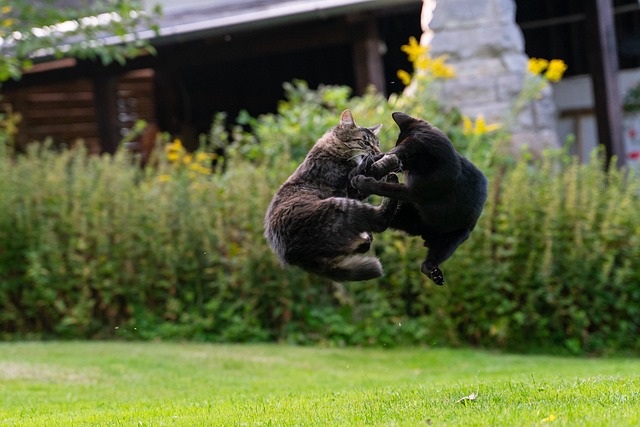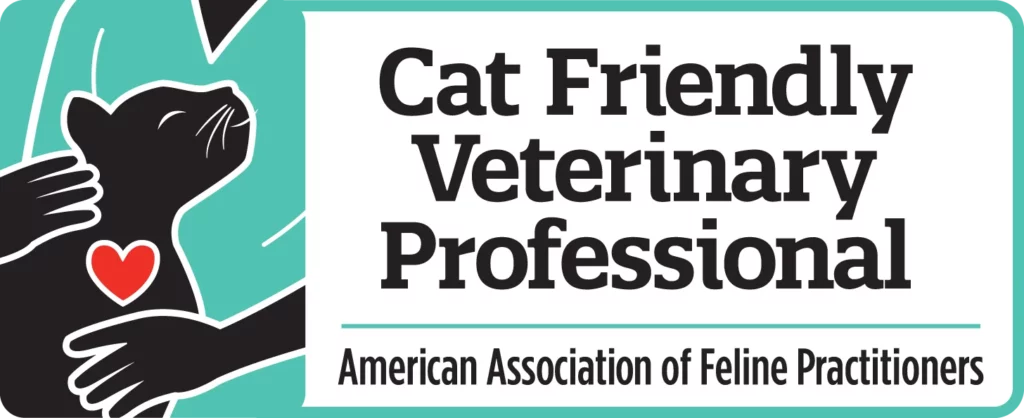Life with multiple cats can be great: lots of purrs, more snuggles, and cats that may keep each other entertained. Life with fighting cats is less enjoyable, however. Even cats that have gotten along well for years can suddenly stop being buddies in the wrong set of circumstances.
You may or may not have witnessed the triggering event or the first fight. Heck, in some cases it may not have been something you would have thought would have caused problems between the cats.
One common scenario I see frequently with clients goes like this: Two cats who have lived together for years in blissful feline harmony. One day, one of the cats goes to the veterinarian for a routine check-up, a dental procedure, or needs to see the vet for any number of reasons. Upon their return, they’re acting a little off, but that’s understandable. The vet can be stressful! (But regular trips to the veterinarian are absolutely necessary)
The cats may be fine with each other for a while or something may happen right away, but eventually, a fight breaks out and you quickly break up the cat fight. At that moment, the cats’ relationship is broken. The cats, who previously would lounge and play together, can’t be in the same room with each other without there being conflict. Even if the cats can be in the room with each other, they may seem more stressed than usual and don’t quite seem the same.

When cats who previously got along seem more like enemies, it can be extremely tough on the humans, too. You just want to see your sweet cats be buddies again and not have to worry about if one will claw at the other cat just for existing. Will life ever be the same?
Why Do Cats Fight?
While the reasons for fighting cats vary, in the situation described above the reasoning is that the cats don’t recognize each other. This may seem odd to us, but smell is a huge influence on how cats recognize each other. If one cat returns from the vet smelling and acting differently, the other cat may see them as different enough to think they are an unfamiliar cat.
Cats are extremely territorial and unfamiliar cats are often met with suspicion and hostility. One cat, understandably afraid because there is now a threat in their territory, moves to defend themselves. The other cat, who may have recognized their buddy, now feels threatened and becomes frightened whenever they see their former friend.
Other times, cats never got along in the first place. It may be due to a personality mismatch or because the cats were introduced incorrectly. The cats end up fearful of each other and each fight further reinforces that fearful response.

In other cases, it may be due to the cats misinterpreting a scary event. For example, if you drop a pan near one of your cats, they’ll likely be pretty spooked by the sound. If they’re looking at or in the vicinity of another cat, they may misinterpret the other cat as being the source of the fear or try to alleviate their anxiety by aggressing toward the cat.
What Do I Do If My Cats Are Fighting?
When this happens, you’ll probably want to return your home to normal as quickly as possible. In some cases, the cats may return to baseline even without you doing much. Unfortunately, these situations often require time to resolve. In order to get the cats back to being friends again, you might need to go through a process called a reintroduction.
What Are Reintroductions?
Reintroductions are ways of teaching each cat that the other cat is not only not a threat, but that good things happen when the other cat is around. The process is often successful if done correctly, but it can take months in many cases to get things back to somewhat normal. It also can become more difficult the more negative interactions the cats have. In some cases, it may not be resolvable and rehoming is the best choice.
Reintroductions involve repeating the process of introducing cats for the first time, but are more precise and require going slower. You also need to keep the cats totally separated during the process except when you’re trying to let them see each other.
Because the process is so long and taxing on the humans involved, doing it alone can be tough even if you follow a reliable guide. Fortunately, I’m very experienced with going through this process. Reintroductions are, without question, the most common reason I am contacted to help folks with their cats. If you are interested in giving one a try and are prepared to put in some work, I’m happy to help you out.
What Are Alternatives To A Reintroduction?
If a reintroduction isn’t something you want to try right away, you can do a few things to avoid one. They have varying success rates, but it may be worth giving it a good go. And, of course, if you have fighting cats and want my advice on if you need a reintroduction, feel free to set up a behavior consultation.
While not a magic solution, you can start by trying a Feliway Multicat plugin. The plugin contains pheromones that help promote social cohesion between cats. I rarely see this alone work for fighting cats, but it does help supplement other interventions.
If you can identify a source of your cats’ conflict, try to address the problem without using something that will scare the cats. You don’t want to make them more fearful of each other! For example, if your cats have a favorite cat tower that they both want to use, consider adding a second cat tree. This will likely stop further fighting, though there may be may be work to do to undo any damage to their relationship.
You can also try separating the cats for a few hours or days to see how they do. When separating them, you want to make sure they have all their needs met. The cats also can’t see each other at all during this time. You may need to use an under the door draft guard to block them from playing with each other through the door gap or a window film to prevent them from seeing each other through windows.
What Not To Do
There are a few things you really shouldn’t do. While back in the day it was common to just let the cats fight it out, we now realize that’s a terrible idea. The cats won’t always work it out and you risk them getting injured. It’s better to help the process along and try to get them to get along calmly.
While many guides suggest feeding the cats near each other, this actually isn’t as helpful as it’s made out to be. While building a positive association with each other is a good idea, cats prefer eating separately from each other so making them eat near each other may actually cause more trouble. The cats may also put up with each other because they really just want to eat, but still actively dislike each other. Skip this as it’s not helpful.
If your cats are actively fighting, you’ll want to safely break up the cat fight without sticking your hands between the cats. That’s a great way to get bitten by a cat.
Is There Hope For My Fighting Cats?
This is the most common question I’m asked when contacted by prospective clients. While there are many things that can make it more or less likely for fight cats to at least tolerate each other, in many cases there is hope. Sometimes things will naturally get better. Other times, you’ll need to help the cats along. In many situations, with a little (or a lot) of patience, you can have a house without the constant hiss of cats trying to murder each other.










